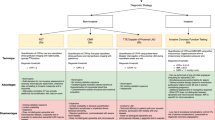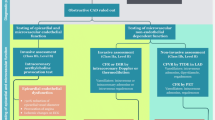Abstract
Purpose of Review
We will review the available data on the epidemiology, pathophysiology, diagnosis, and management of microvascular coronary dysfunction (MCD).
Recent Findings
The study of MCD was pioneered by the Women’s Ischemia Syndrome Evaluation (WISE) cohort. New techniques in the diagnosis of this condition, using invasive and noninvasive means, are helping to increase awareness of this condition as well as ways in which to treat it.
Summary
Microvascular coronary disease without epicardial involvement has become an increasingly recognized cause of cardiac chest pain, particularly in women. Dysfunction of the microvasculature related to endothelium-dependent and endothelial-independent factors likely results in symptoms and/or evidence of ischemia. Although there is a growing body of research, there is still much about MCD that we do not understand.
Similar content being viewed by others
References
Kochanek KD, Murphy SL, Xu J, Tejada-Vera B. Deaths: final data for 2014. Natl Vital Stat Rep. 2016;65(4):1–122.
Thom T, Haase N, Rosamond W, Howard VJ, Rumsfeld J, Manolio T, et al. Heart disease and stroke statistics—2006 update: a report from the American Heart Association Statistics Committee and Stroke Statistics Subcommittee. Circulation. 2006;113(6):e85–151. https://doi.org/10.1161/CIRCULATIONAHA.105.171600.
Diver DJ, Bier JD, Ferreira PE, Sharaf BL, McCabe C, Thompson B, et al. Clinical and arteriographic characterization of patients with unstable angina without critical coronary arterial narrowing (from the TIMI-IIIA Trial). Am J Cardiol. 1994;74(6):531–7. https://doi.org/10.1016/0002-9149(94)90739-0.
Sullivan AK, Holdright DR, Wright CA, Sparrow JL, Cunningham D, Fox KM. Chest pain in women: clinical, investigative, and prognostic features. BMJ. 1994;308(6933):883–6. https://doi.org/10.1136/bmj.308.6933.883.
Merz CN, Kelsey SF, Pepine CJ, Reichek N, Reis SE, Rogers WJ, et al. The Women’s Ischemia Syndrome Evaluation (WISE) study: protocol design, methodology and feasibility report. J Am Coll Cardiol. 1999;33(6):1453–61. https://doi.org/10.1016/S0735-1097(99)00082-0.
Reis SE, Holubkov R, Conrad Smith AJ, Kelsey SF, Sharaf BL, Reichek N, et al. Coronary microvascular dysfunction is highly prevalent in women with chest pain in the absence of coronary artery disease: results from the NHLBI WISE study. Am Heart J. 2001;141(5):735–41. https://doi.org/10.1067/mhj.2001.114198.
Marcus ML, Chilian WM, Kanatsuka H, Dellsperger KC, Eastham CL, Lamping KG. Understanding the coronary circulation through studies at the microvascular level. Circulation. 1990;82(1):1–7. https://doi.org/10.1161/01.CIR.82.1.1.
Camici PG, d’Amati G, Rimoldi O. Coronary microvascular dysfunction: mechanisms and functional assessment. Nat Rev Cardiol. 2015;12(1):48–62. https://doi.org/10.1038/nrcardio.2014.160.
Panza JA. Coronary atherosclerosis: extending to the microcirculation? Eur Heart J. 2010;31(8):905–7. https://doi.org/10.1093/eurheartj/ehq044.
Knaapen P, Camici PG, Marques KM, Nijveldt R, Bax JJ, Westerhof N, et al. Coronary microvascular resistance: methods for its quantification in humans. Basic Res Cardiol. 2009;104(5):485–98. https://doi.org/10.1007/s00395-009-0037-z.
Camici PG, Crea F. Coronary microvascular dysfunction. N Engl J Med. 2007;356(8):830–40. https://doi.org/10.1056/NEJMra061889.
Kuo L, Chilian WM, Davis MJ. Coronary arteriolar myogenic response is independent of endothelium. Circ Res. 1990;66(3):860–6. https://doi.org/10.1161/01.RES.66.3.860.
Sodha NR, Boodhwani M, Clements RT, Feng J, SH X, Sellke FW. Coronary microvascular dysfunction in the setting of chronic ischemia is independent of arginase activity. Microvasc Res. 2008;75(2):238–46. https://doi.org/10.1016/j.mvr.2007.06.008.
Liu Y, Gutterman DD. Vascular control in humans: focus on the coronary microcirculation. Basic Res Cardiol. 2009;104(3):211–27. https://doi.org/10.1007/s00395-009-0775-y.
Kaufmann PA, Gnecchi-Ruscone T, Schafers KP, Luscher TF, Camici PG. Low density lipoprotein cholesterol and coronary microvascular dysfunction in hypercholesterolemia. J Am Coll Cardiol. 2000;36(1):103–9. https://doi.org/10.1016/S0735-1097(00)00697-5.
Naoumova RP, Kindler H, Leccisotti L, Mongillo M, Khan MT, Neuwirth C, et al. Pioglitazone improves myocardial blood flow and glucose utilization in nondiabetic patients with combined hyperlipidemia: a randomized, double-blind, placebo-controlled study. J Am Coll Cardiol. 2007;50(21):2051–8. https://doi.org/10.1016/j.jacc.2007.07.070.
Camici PG, Olivotto I, Rimoldi OE. The coronary circulation and blood flow in left ventricular hypertrophy. J Mol Cell Cardiol. 2012;52(4):857–64. https://doi.org/10.1016/j.yjmcc.2011.08.028.
Recio-Mayoral A, Rimoldi OE, Camici PG, Kaski JC. Inflammation and microvascular dysfunction in cardiac syndrome X patients without conventional risk factors for coronary artery disease. JACC Cardiovasc Imaging. 2013;6(6):660–7. https://doi.org/10.1016/j.jcmg.2012.12.011.
Jones E, Eteiba W, Merz NB. Cardiac syndrome X and microvascular coronary dysfunction. Trends Cardiovasc Med. 2012;22(6):161–8. https://doi.org/10.1016/j.tcm.2012.07.014.
Murthy VL, Naya M, Taqueti VR, Foster CR, Gaber M, Hainer J, et al. Effects of sex on coronary microvascular dysfunction and cardiac outcomes. Circulation. 2014;129(24):2518–27. https://doi.org/10.1161/CIRCULATIONAHA.113.008507.
Crea F, Camici PG, Bairey Merz CN. Coronary microvascular dysfunction: an update. Eur Heart J. 2014;35(17):1101–11. https://doi.org/10.1093/eurheartj/eht513.
Shaw LJ, Merz CN, Pepine CJ, Reis SE, Bittner V, Kip KE, et al. The economic burden of angina in women with suspected ischemic heart disease: results from the National Institutes of Health–National Heart, Lung, and Blood Institute-sponsored Women’s Ischemia Syndrome Evaluation. Circulation. 2006;114(9):894–904. https://doi.org/10.1161/CIRCULATIONAHA.105.609990.
Diez-Delhoyo F, Gutierrez-Ibanes E, Loughlin G, Sanz-Ruiz R, Vazquez-Alvarez ME, Sarnago-Cebada F, et al. Coronary physiology assessment in the catheterization laboratory. World J Cardiol. 2015;7(9):525–38. https://doi.org/10.4330/wjc.v7.i9.525.
Fearon WF, Balsam LB, Farouque HM, Caffarelli AD, Robbins RC, Fitzgerald PJ, et al. Novel index for invasively assessing the coronary microcirculation. Circulation. 2003;107(25):3129–32. https://doi.org/10.1161/01.CIR.0000080700.98607.D1.
Thomson LE, Wei J, Agarwal M, Haft-Baradaran A, Shufelt C, Mehta PK, et al. Cardiac magnetic resonance myocardial perfusion reserve index is reduced in women with coronary microvascular dysfunction. A National Heart, Lung, and Blood Institute-sponsored study from the Women’s Ischemia Syndrome Evaluation. Circ Cardiovasc Imaging. 2015;8(4):e002481. https://doi.org/10.1161/CIRCIMAGING.114.002481.
Naderi S, Cho LS. Cardiovascular disease in women: prevention, symptoms, diagnosis, pathogenesis. Cleve Clin J Med. 2013;80(9):577–87. https://doi.org/10.3949/ccjm.80a.13005.
Bonetti PO, Lerman LO, Lerman A. Endothelial dysfunction: a marker of atherosclerotic risk. Arterioscler Thromb Vasc Biol. 2003;23(2):168–75. https://doi.org/10.1161/01.ATV.0000051384.43104.FC.
Sun BJ, Hwang E, Jang JY, Kim DH, Song JM, Kang DH. Effect of rosuvastatin on coronary flow reserve in patients with systemic hypertension. Am J Cardiol. 2014;114(8):1234–7. https://doi.org/10.1016/j.amjcard.2014.07.046.
Zhou MS, Schulman IH, Raij L. Nitric oxide, angiotensin II, and hypertension. Semin Nephrol. 2004;24(4):366–78. https://doi.org/10.1016/j.semnephrol.2004.04.008.
Luscher TF, Yang Z. Calcium antagonists and ACE inhibitors. Effect on endothelium and vascular smooth muscle. Drugs. 1993;46(Suppl 2):121–32. https://doi.org/10.2165/00003495-199300462-00021.
Pauly DF, Johnson BD, Anderson RD, Handberg EM, Smith KM, Cooper-DeHoff RM, et al. In women with symptoms of cardiac ischemia, nonobstructive coronary arteries, and microvascular dysfunction, angiotensin-converting enzyme inhibition is associated with improved microvascular function: a double-blind randomized study from the National Heart, Lung and Blood Institute Women’s Ischemia Syndrome Evaluation (WISE). Am Heart J. 2011;162(4):678–84. https://doi.org/10.1016/j.ahj.2011.07.011.
Cannon RO 3rd, Watson RM, Rosing DR, Epstein SE. Efficacy of calcium channel blocker therapy for angina pectoris resulting from small-vessel coronary artery disease and abnormal vasodilator reserve. Am J Cardiol. 1985;56(4):242–6. https://doi.org/10.1016/0002-9149(85)90842-2.
Lanza GA, Colonna G, Pasceri V, Maseri A. Atenolol versus amlodipine versus isosorbide-5-mononitrate on anginal symptoms in syndrome X. Am J Cardiol. 1999;84(7):854–6, A8. https://doi.org/10.1016/S0002-9149(99)00450-6.
Togni M, Vigorito F, Windecker S, Abrecht L, Wenaweser P, Cook S, et al. Does the beta-blocker nebivolol increase coronary flow reserve? Cardiovasc Drugs Ther. 2007;21(2):99–108. https://doi.org/10.1007/s10557-006-0494-7.
Mehta PK, Goykhman P, Thomson LE, Shufelt C, Wei J, Yang Y, et al. Ranolazine improves angina in women with evidence of myocardial ischemia but no obstructive coronary artery disease. JACC Cardiovasc Imaging. 2011;4(5):514–22. https://doi.org/10.1016/j.jcmg.2011.03.007.
Jespersen L, Hvelplund A, Abildstrom SZ, Pedersen F, Galatius S, Madsen JK, et al. Stable angina pectoris with no obstructive coronary artery disease is associated with increased risks of major adverse cardiovascular events. Eur Heart J. 2012;33(6):734–44. https://doi.org/10.1093/eurheartj/ehr331.
Mygind ND, Michelsen MM, Pena A, Frestad D, Dose N, Aziz A, et al. Coronary microvascular function and cardiovascular risk factors in women with angina pectoris and no obstructive coronary artery disease: the iPOWER study. J Am Heart Assoc. 2016;5(3):e003064. https://doi.org/10.1161/JAHA.115.003064.
Suwaidi JA, Hamasaki S, Higano ST, Nishimura RA, Holmes DR Jr, Lerman A. Long-term follow-up of patients with mild coronary artery disease and endothelial dysfunction. Circulation. 2000;101(9):948–54. https://doi.org/10.1161/01.CIR.101.9.948.
Pepine CJ, Anderson RD, Sharaf BL, Reis SE, Smith KM, Handberg EM, et al. Coronary microvascular reactivity to adenosine predicts adverse outcome in women evaluated for suspected ischemia results from the National Heart, Lung and Blood Institute WISE (Women’s Ischemia Syndrome Evaluation) study. J Am Coll Cardiol. 2010;55(25):2825–32. https://doi.org/10.1016/j.jacc.2010.01.054.
Author information
Authors and Affiliations
Corresponding author
Ethics declarations
Conflict of Interest
Sahar Naderi declares no conflict of interest.
Human and Animal Rights and Informed Consent
This article does not contain any studies with human or animal subjects performed by the author.
Additional information
This article is part of the Topical Collection on Coronary Heart Disease
Rights and permissions
About this article
Cite this article
Naderi, S. Microvascular Coronary Dysfunction—an Overview. Curr Atheroscler Rep 20, 7 (2018). https://doi.org/10.1007/s11883-018-0710-5
Published:
DOI: https://doi.org/10.1007/s11883-018-0710-5




